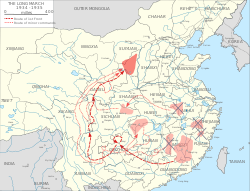Chinese Soviet Republic
| Chinese Soviet Republic | ||||||||||||
| 中華蘇維埃共和國 | ||||||||||||
|
||||||||||||
|
||||||||||||
|
Motto 全世界無產階級和被壓迫的民族聯合起來 "Quánshìjiè wúchǎnjiējí hé bèi yāpò de mínzú liánhé qǐlai!" "Proletariats and Oppressed Peoples of the World, Unite!" |
||||||||||||
|
Anthem The Internationale |
||||||||||||
|
Map of the CCP Soviets comprising the Chinese Soviet Republic and the route of the Long March
|
||||||||||||
| Capital | ||||||||||||
| Languages | Chinese | |||||||||||
| Religion | None (state atheism) | |||||||||||
| Government | Unitary Maoist One-party socialist republic | |||||||||||
| Prime Minister | Mao Zedong | |||||||||||
| Historical era | Interwar period | |||||||||||
| • | Established | 7 November 1931 | ||||||||||
| • | Disestablished | 22 September 1937 | ||||||||||
|
||||||||||||
| Chinese Soviet Republic | |||||||||||
| Traditional Chinese | 中華蘇維埃共和國 | ||||||||||
|---|---|---|---|---|---|---|---|---|---|---|---|
| Simplified Chinese | 中华苏维埃共和国 | ||||||||||
|
|||||||||||
| Transcriptions | |
|---|---|
| Standard Mandarin | |
| Hanyu Pinyin | Zhōnghuá Sūwéi'āi Gònghéguó |
| Wade–Giles | Chunghua Suwei'ai Kunghekuo |
| IPA | [ʈʂʊ́ŋxwǎ súwěiái kʊ̂ŋxɤ̌kwǒ] |
The Chinese Soviet Republic (CSR), also known as the Soviet Republic of China or the China Soviet Republic, is often referred to in historical sources as the Jiangxi Soviet (after its largest component territory, the Jiangxi-Fujian Soviet). It was established in November 1931 by future Communist Party of China leader Mao Zedong, General Zhu De and others, and it lasted until 1937. territories included the Northeastern Jiangxi, Hunan-Jiangxi, Hunan-Hubei-Jiangxi, Hunan-Western Hubei, Hunan-Hubei-Sichuan-Guizhou, Shaanxi-Gansu, Szechuan-Shensi, Hubei-Henan-Anhui, Honghu and Haifeng-Lufeng Soviets. Mao Zedong was both CSR state chairman and prime minister; he led the state and its government. Mao's tenure as head of a "small state within a state" gave him experience in mobile warfare and peasant organization; this experience helped him accomplish the Communist reunification of China during the late 1940s. The CSR was eventually destroyed by the Kuomintang (KMT)'s National Revolutionary Army in a series of 1934 encirclement campaigns. Following the Xi'an Incident of December 1936, the Communists and Kuomintang formed an uneasy "United Front" to resist Japanese pressure, which led to the Communists recognizing at least for the moment Chiang Kai-shek as China's leader and the official dissolution of the Soviet Republic on 22 September 1937.
...
Wikipedia



